Physical Address
304 North Cardinal St.
Dorchester Center, MA 02124
The so-called Rathke diagram, showing six pairs of arteries encircling the tracheoesophageal pedicle, is still frequently used to provide an understanding of the morphogenesis of abnormalities of the brachiocephalic arteries in human patients with congenitally malformed hearts ( Fig. 48.1 ). The existence of six sets of arteries in mammalian species, however, has proved controversial for well over a century. As long ago as 1907, the potential candidates for the purported fifth arch arteries had been reviewed, with the conclusion reached that no known arrangement paralleled this morphology seen in lower animals. Subsequent to an investigation of normal development, it was argued that further studies were required before it could justifiably be presumed that such arteries of the purported fifth pharyngeal arch were part of normal development. As yet, despite several such further studies, evidence for the existence of fifth arch arteries remains scant. Extensive studies performed in developing mouse embryos, for example, have failed to provide evidence not only for the fifth arch arteries but also for the presence of segments of pharyngeal mesenchyme that might contain the alleged channels. Nonetheless, in up to half of the embryos studied, collateral channels were found between the distal extents of the fourth and sixth arch arteries. These collateral channels were also found by other groups investigating the developing mouse heart but inappropriately described as fifth arch arteries. We did discover in a solitary human specimen remnants of an artery that had extended through the pharyngeal mesenchyme from the aortic sac to the dorsal aorta, paralleling the course of the fourth and sixth arch arteries. To the best of our knowledge, this is the only channel thus far described during normal development that takes a path from the extrapericardial systemic outflow tract to the descending aorta and the pulmonary arteries.
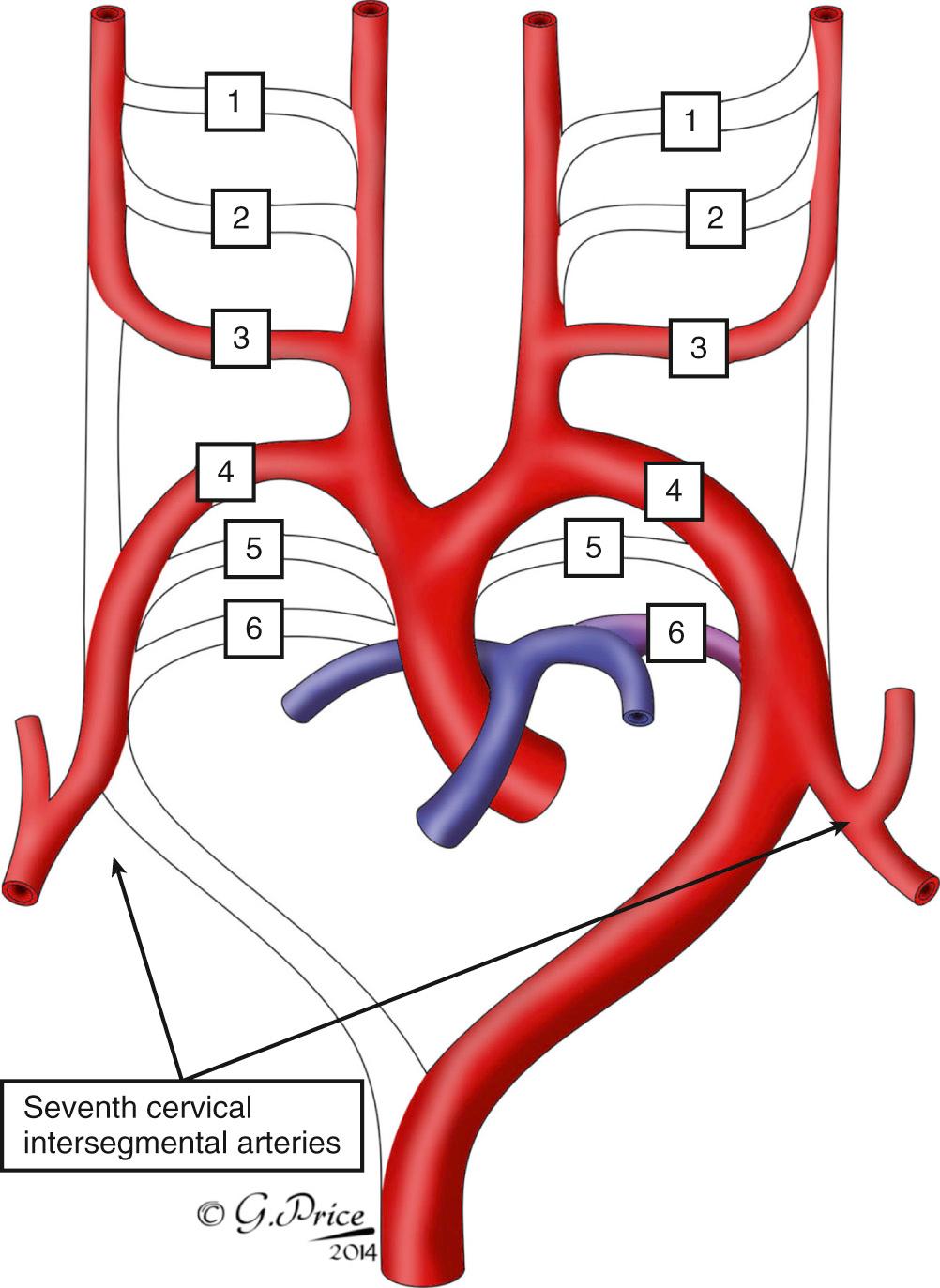
However, a host of structures have been interpreted by pediatric cardiologists as representing persistent arteries of the fifth pharyngeal arch. Many of these entities produce the lesions known as double-barreled aortas, with other variants producing systemic-to-pulmonary collateral channels or abnormal branching of the brachiocephalic arteries. The majority, in our opinion, are better interpreted on the basis of persistence of the collateral channels or remodeling of the aortic sac and the arteries of the third, fourth, and sixth arches. This chapter describes the changes that take place during the formation of the extrapericardial pulmonary and aortic pathways in the mouse heart. We also show the vessel discovered in a human embryo that, to the best of our knowledge, is the only structure thus far encountered that satisfies the criteria for an artery of the fifth pharyngeal arch. We then explain why we believe that many of the accounts provided in the world literature are better explained on the basis of persistent collateral channels or remodeling of the developing brachiocephalic and pulmonary arteries. We nonetheless accept that some of the channels providing systemic-to-pulmonary communications could well represent persistence of the arteries of the enigmatic fifth arch, illustrating features that warrant such descriptions.
As described in Chapter 3 , the intrapericardial components of the arterial trunks are formed within the distal part of the outflow tract. They are produced by the ongoing migration of nonmyocardial cells into the arterial pole of the heart from the second heart field and the neural crest during the ninth and tenth days of murine development. The series of paired arteries that connect the extrapericardial aortic sac to the initially paired dorsal aortas extend through segments of pharyngeal mesenchyme and encircle the tracheoesophageal pedicle. The segments of pharyngeal mesenchyme, along with their contained arteries, develop in sequence and in a cranial-to-caudal direction. Each protuberance, or arch, is covered by endoderm on the inside and by ectoderm on the outside. The first four arches also contain a mesodermal core along with additional mesenchyme derived from the neural crest. As far as we know, the sequence and mechanism of formation of the arches and their contained arteries as seen in the mouse is paralleled in the developing human heart. Since the sequence has best been investigated in the mouse, we use these images to demonstrate the changes. The arterial channels are first seen during the latter half of murine embryonic day 8 and continue to appear during embryonic day 9.5 ( Fig. 48.2 ). By the end of murine embryonic day 9.5, which is equivalent to Carnegie stage 11 in the developing human, three pairs of arteries occupy the first through third pairs of pharyngeal arches. By the beginning of embryonic day 10.5, by which time the fourth pair of arteries has begun to appear, the arteries in the first and second arches have already begun to regress. These vessels form a capillary network within the developing jaw but make no significant contribution to the final structure of the brachiocephalic branches of the aortic arch. Formation of the sixth pair of arches takes place during the latter part of embryonic day 10.5 ( Fig. 48.3 ). Like the arteries of the first four arches, the sixth arch arteries also occupy a discrete segment of pharyngeal mesenchyme. Unlike the first four arches, however, the sixth pharyngeal arches do not contain bony, muscular, or neural elements.
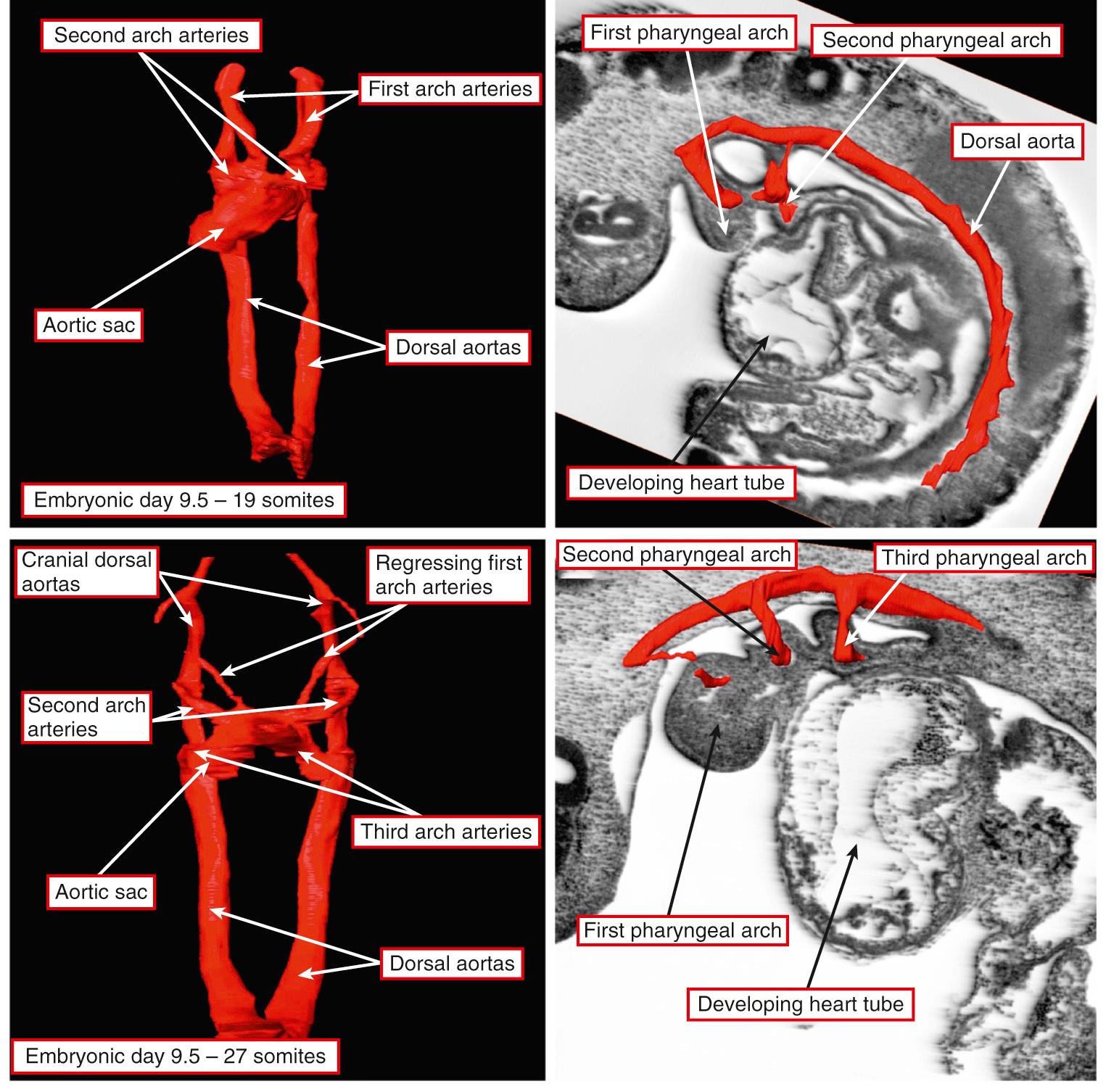
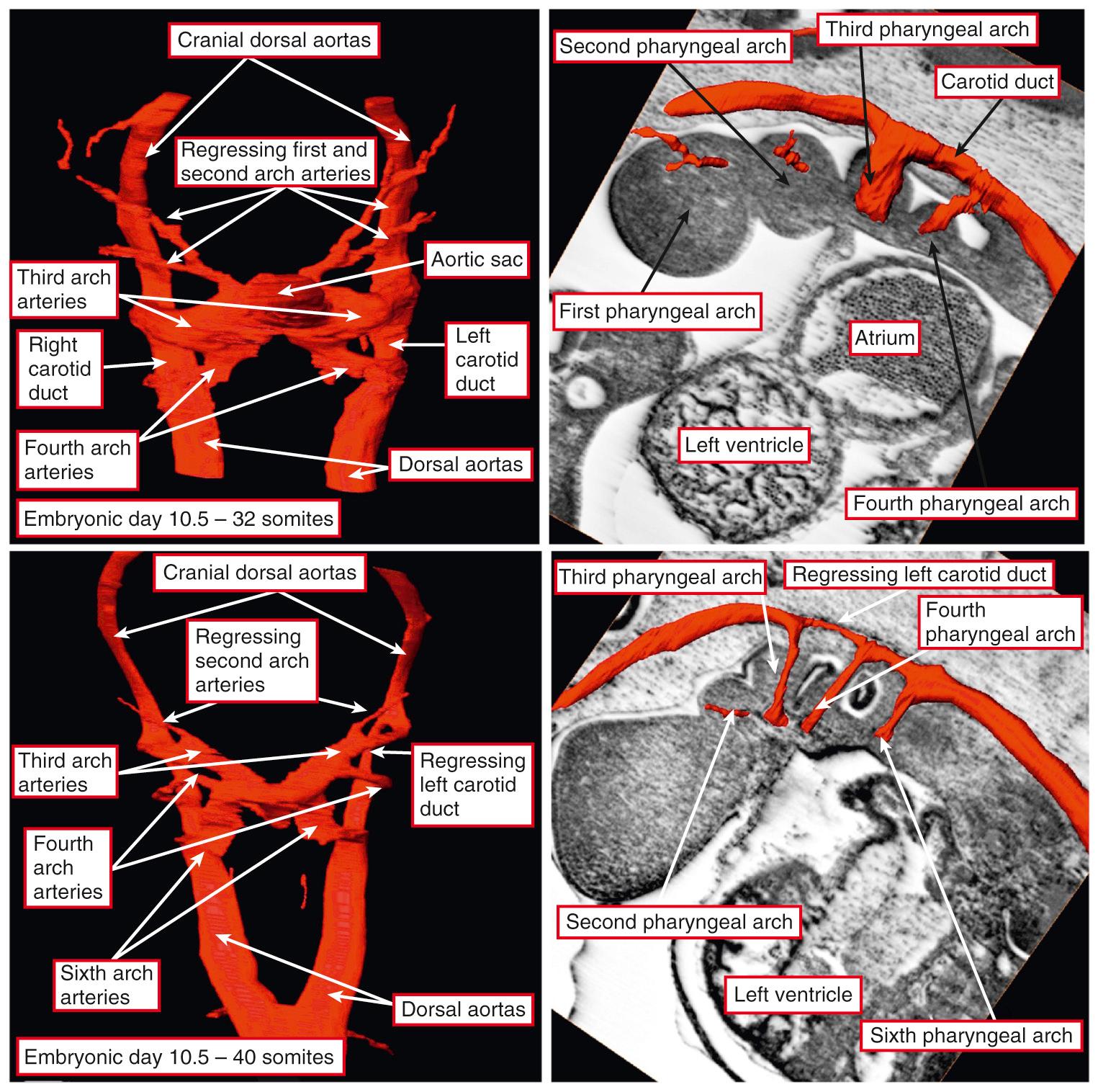
By the beginning of embryonic day 11.5, the bilateral symmetry of the arteries is readily evident, although by this time only three sets of arteries are recognizable. This is due to the regression of the arteries of the first and second arches ( Fig. 48.4 ). It is during embryonic day 11.5 that collateral channels can be found in up to half of all the embryos (see Fig. 48.4 , right ), although the collateral channels are not seen prior to the formation of the sixth pair of arch arteries. The initially bilaterally symmetric system undergoes rapid remodeling during embryonic days 11.5 and 12 to form the mature branches that take their origin from the developing aortic arch. The remodeling is first seen in the right sixth arch artery, which thins and involutes during embryonic day 11.5. This is accompanied by subsequent regression of the right-sided dorsal aorta ( Fig. 48.5 ). Prior to the remodeling, the segments of the dorsal aortas between the insertions of the third and fourth arch arteries along with their cranial continuations have been recognizable as the carotid ducts (see Figs. 48.2 and 48.3 ). These vessels also markedly reduce in size during embryonic day 11.5 (see Fig. 48.4 ) and have disappeared by the end of embryonic day 12.5 (see Fig. 48.5 , left ). The arteries of the third arches continue cranially into the remaining parts of the dorsal aortas, thus forming the internal carotid arteries. With regression of the right-sided dorsal aorta, the left horn of the aortic sac gives rise to the artery of the left fourth arch and expands to form the definitive aortic arch, with the artery of the left sixth arch recognizable as the arterial duct. The right horn of the aortic sac also undergoes remodeling to form a confluent channel that gives rise to the arteries of the right fourth and third arches. At this stage, however, there has been no formation of the subclavian arteries. These vessels are derived from the seventh cervical intersegmental arteries. They will become the subclavian arteries, but major movement is required on both the right and left sides before they reach their definitive location. This is because these arteries initially occupy a position that is markedly caudal to their eventual definitive position (see Fig. 48.5 , left ). Although it seems that the cervical intersegmental arteries migrate cranially, it is more likely that the pharyngeal mesenchyme containing the arch arteries themselves, along with the developing heart, moves caudally. Regardless of the precise mechanics, the end result is that the arteries themselves remodel such that the vessel on the left side crosses the union of the left sixth arch artery with the dorsal aorta. This movement, which can be likened to the “castling” movement in chess when considered relative to the arterial duct, divides the left fourth arch artery into the transverse segment of the definitive aortic arch and the aortic isthmus (see Fig. 48.5 , right ). Even more marked relative movement takes place on the right side, such that the intersegmental artery achieves union with the right horn of the aortic sac, which becomes the brachiocephalic trunk (see Fig. 48.5 , right ). However, none of the mouse embryos that we have studied thus far has shown any evidence for the existence of a fifth pharyngeal pouch or a set of fifth pharyngeal arch arteries.
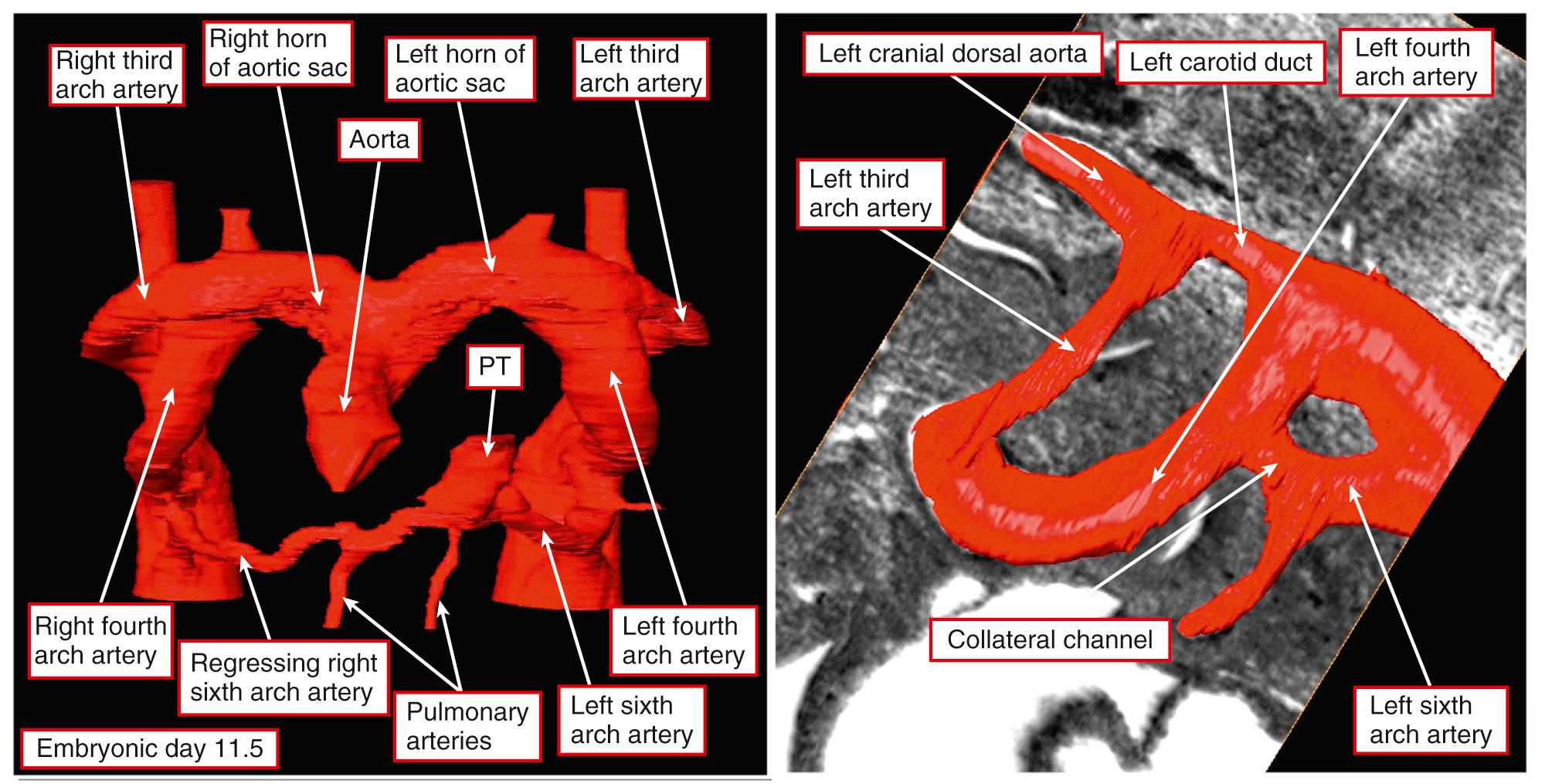
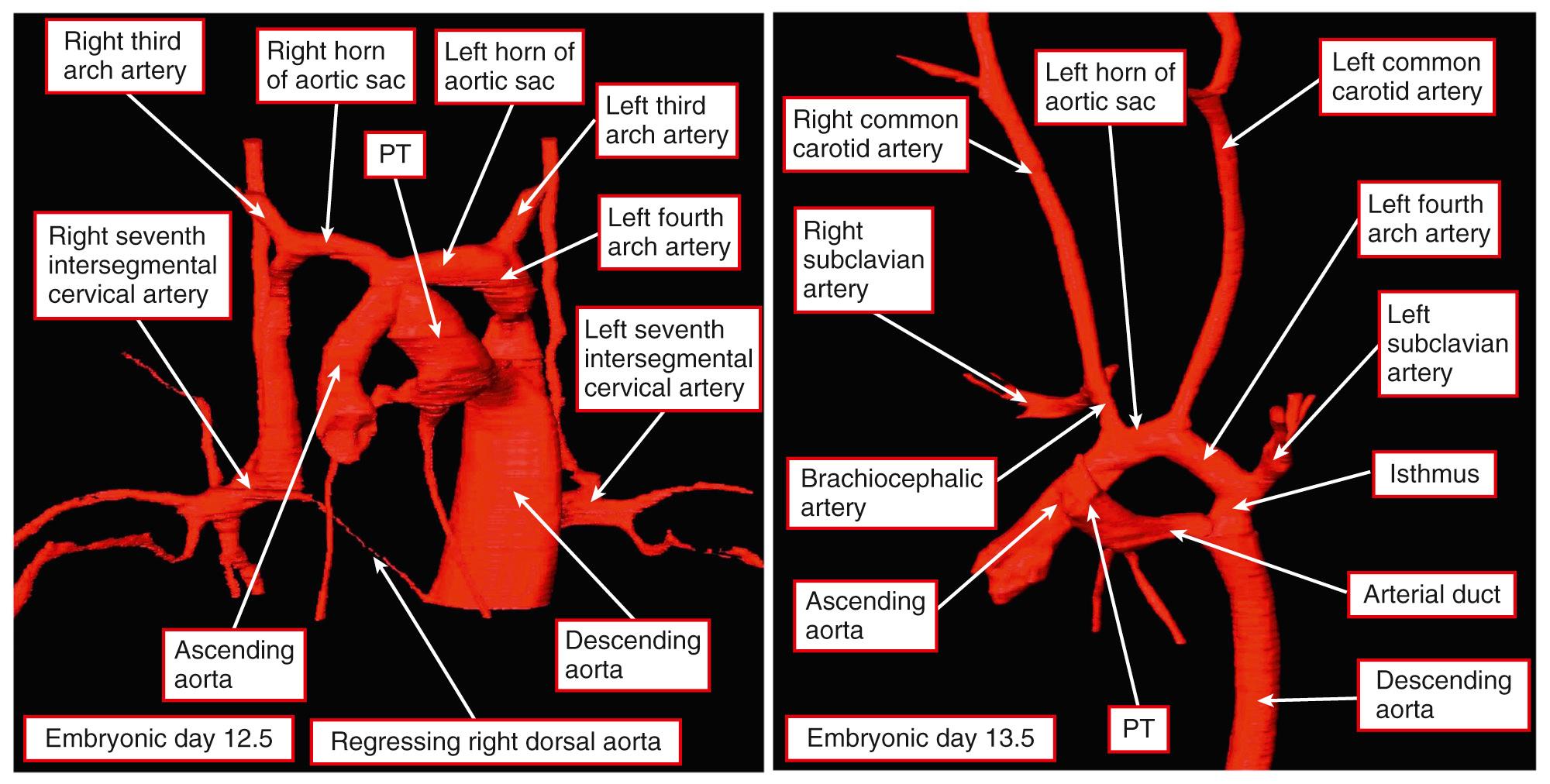
We have studied a much smaller number of developing human embryos. In one of these embryos we found a specimen with remnants of a channel that qualifies as an artery of the fifth pharyngeal arch. This artery, which was left-sided, not only paralleled the course of the developing fourth and sixth arch arteries ( Fig. 48.6A ) but was also contained within a discrete segment of pharyngeal mesenchyme ( Fig. 48.6B ). Had the artery persisted in its entirety, it would have extended from an origin in the aortic sac to an insertion in the sixth arch artery and thence to the descending aorta (see Fig. 48.6 ). We suggest that the course of this vessel should serve as the exemplar for candidates to be considered as persistent fifth arch arteries. To justify their existence as arteries of the fifth arch, the channels should therefore run an extrapericardial course, having taken their origin from the ascending aorta. If they are feeding the pulmonary circulation, this should be through a dorsal serpentine continuation with the sixth arch.
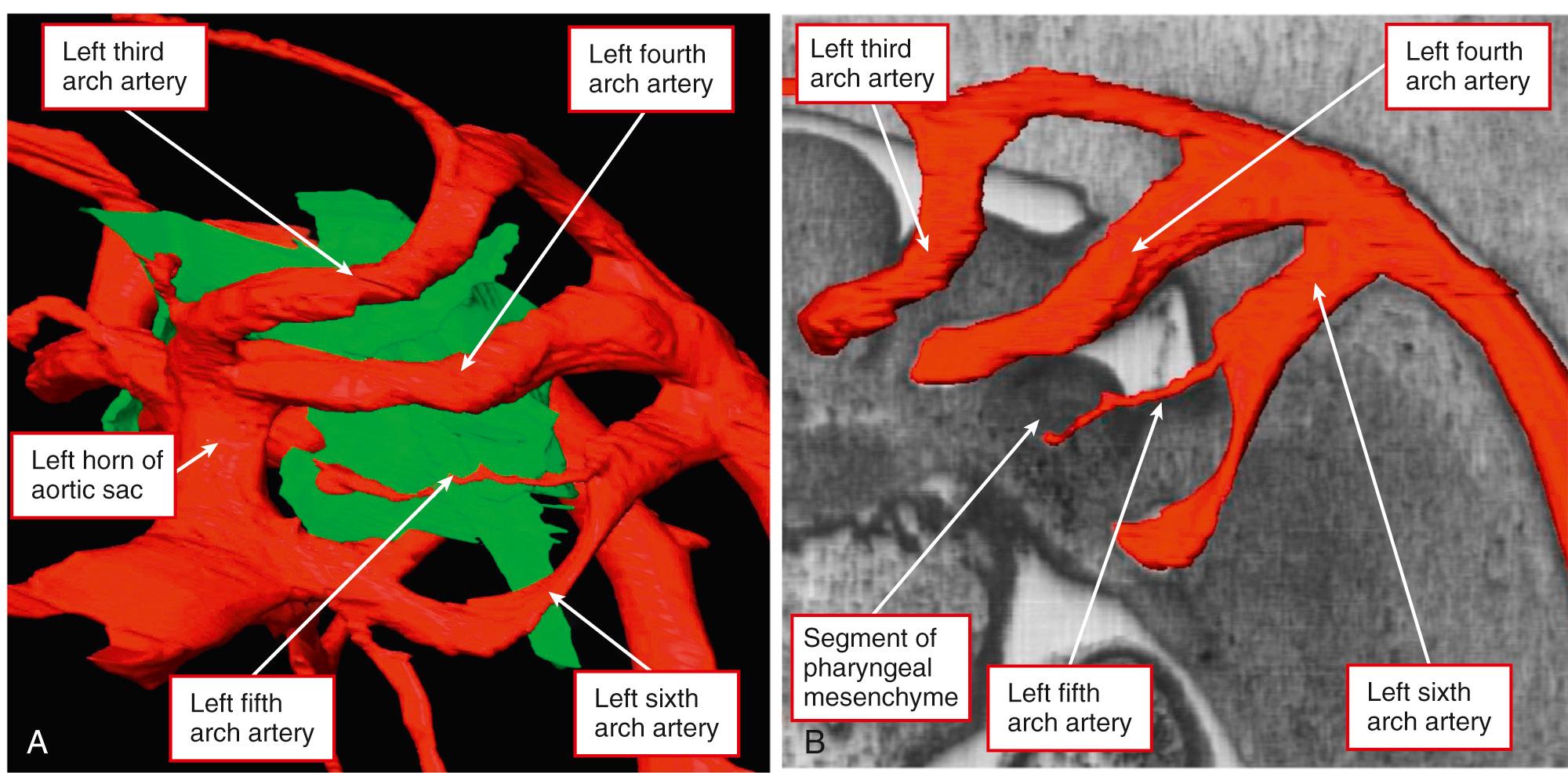
Pediatric cardiologists have interpreted multiple channels found in the extrapericardial arterial pathways as persistent arteries of the fifth pharyngeal pouch. Following a systematic review of the cases existing at that time, Freedom suggested that the candidates could be classified as providing systemic-to-systemic channels, or systemic-to-pulmonary pathways, pulmonary-to-systemic entities, or they could persist bilaterally. The initial channel categorized in this way was a systemic-to-systemic channel that produced a double-barreled aorta. The authors of the initial description highlighted the origin of the proposed fifth arch from the ascending aorta proximal to the brachiocephalic artery. Such was the impact of their initial observation that many subsequent investigators labeled any vessel arising from the distal part of the ascending aorta as persistence of the fifth arch artery. We now know that, during embryogenesis, there is differential growth of medial and lateral surfaces of the aorta. This, in turn, creates the potential for marked variation in the position of the brachiocephalic artery relative to the channel presumed to be the fifth arch artery. There is still further potential variation in the relationship of the proximal origin of the arterial duct to the origin of the brachiocephalic artery. This anatomic variability further complicates the assessment of the three-dimensional orientation of the aortic arch and its branches, creating particular difficulty in demonstrating clinically that the origin of any extra vessel is unequivocally proximal to the origin of the brachiocephalic artery. Although this may be possible when using computed tomography or magnetic resonance imaging, it is extremely difficult if it is based solely on echocardiographic interrogation, as has been the case in many reports. It is also unfortunate that alleged persistence of the artery of the fifth arch has been cited to explain the morphogenesis of several congenital malformations without any attention to the scant support thus far available from developmental studies. A reassessment of many, if not most, of these reports, including those describing communications with the pulmonary arteries, suggests that they may better be considered as representing persisting collateral channels or else explained on the basis of remodeling of the aortic sac and the third, fourth, and sixth arch arteries.
Subsequent to the initial interpretation offered by Van Praagh and Van Praagh, which was endorsed enthusiastically by Gerlis and colleagues, at least 44 cases of double-barreled aorta have been reported as representing fifth arch arteries ( Table 48.1 ). More and more cases are now labeled in this fashion simply because of the presence of the double-lumen aorta. However, many of the investigators making this diagnosis fail to assess the origin of the second channel relative to that of the brachiocephalic artery. As we have emphasized, this relationship is subject to error if not assessed carefully. In one of our own cases with double-barreled aorta, which we studied echocardiographically, the origin of arterial duct proximal to the second channel suggests that the findings are better explained on the basis of persistence of collateral channels combined with remodeling of the lesser curvature of the aortic arch ( Fig. 48.7 ). It is difficult to account for the proximal location of arterial duct in this patient if it is presumed that the second channel is a persistent artery of the fifth pharyngeal arch. Thus far, furthermore, most clinical investigators interpreting double-barreled aorta on the basis of persistence of the artery of the fifth arch have failed to consider the possibility that the second channel is no more than persistence of one of the collateral channels formed between the dorsal insertions of the fourth and sixth arch arteries. As already discussed, such collateral channels were found in up to half of our developing mice and are also to be found in developing human embryos.
| Year | Author | Case | Anatomy of the Proposed Fifth Arch | Reference | |
|---|---|---|---|---|---|
| 1 | 1969 | Van Praagh | 1 | Double-barreled aorta | |
| 2 | 1973 | Izukawa | 1 | Double-barreled aorta with patent arterial duct | |
| 3 | 1973 | Izukawa | 2 | Double-barreled aorta with coarctation | |
| 4 | 1974 | Moes | 1 | Double-barreled aorta with patent arterial duct | |
| 5 | 1975 | Lawrence | 1 | Double-barreled aorta with patent arterial duct | |
| 6 | 1980 | Hirano | 1 | Double-barreled aorta | |
| 7 | 1983 | Diaz- Gongora | 1 | Double-barreled aorta with patent arterial duct | |
| 8 | 1985 | Cabrera | 1 | Double- barreled aorta with patent arterial duct and coarctation | |
| 9 | 1985 | Culham | 1 | Double-barreled aorta with coarctation | |
| 10 | 1987 | Gerlis | 1 | Double-barreled aorta | |
| 11 | 1987 | Herrera | 1 | Double-barreled aorta | |
| 12 | 1989 | Gerlis | 2 | Double-barreled aorta | |
| 13 | 1990 | Geva | 1 | Double-barreled aorta | |
| 14 | 1991 | Gibbin | 1 | Double-barreled aorta with coarctation | |
| 15 | 1997 | Einzig | 1 | Double-barreled aorta | |
| 16 | 1997 | Donti | 1 | Double-barreled aorta | |
| 17 | 1998 | Marinho-da-Silva | 1 | Double-barreled aorta | |
| 18 | 1999 | Wang a | 1 | Double-barreled aorta (right) and left pulmonary artery from aorta | |
| 19 | 1999 | Lambert | 1 | Double-barreled aorta with patent arterial duct and coarctation | |
| 20 | 2002 | McMahon | 1 | Double-barreled aorta | |
| 21 | 2003 | Yang | 1 | Double-barreled aorta | |
| 22 | 2004 | Suda | 1 | Double-barreled aorta with coarctation | |
| 23 | 2004 | Parmar a | 1 | Double-barreled aorta (left) and left pulmonary artery from aorta | |
| 24 | 2005 | Park | 1 | Double-barreled aorta | |
| 25 | 2006 | Baranowska | 1 | Double-barreled aorta with patent arterial duct | |
| 26 | 2006 | Johnston | 1 | Double-barreled aortic arch | |
| 27 | 2006 | Lee | 1 | Double-barreled aorta | |
| 28 | 2006 | Khan | 1 | Double-barreled aorta with coarctation and patent arterial duct | |
| 29 | 2007 | Kirsch | 1 | Double-barreled aorta with patent arterial duct | |
| 30 | 2007 | Bernheimer | 1 | Double-barreled aorta | |
| 31 | 2009 | Santoro | 1 | Double-barreled aorta with coarctation | |
| 32 | 2009 | Kligerman | 1 | Double-barreled aorta | |
| 33 | 2009 | Akhfash | 1 | Double-barreled aorta with coarctation | |
| 34 | 2011 | Linhares | 1 | Double-barreled aorta | |
| 35 | 2011 | Khajali | 1 | Double-barreled aorta with coarctation | |
| 36 | 2011 | Camarda | 1 | Double-barreled aorta | |
| 37 | 2012 | Tehrai | 1 | Double-barreled aorta | |
| 38 | 2012 | Furtado | 1 | Double-barreled aorta | |
| 39 | 2013 | Murugan | 2 | Double-barreled aorta | |
| 40 | 2013 | Warrier | 1 | Double-barreled aorta with patent arterial duct | |
| 41 | 2015 | Schicchi | 1 | Double-barreled aorta with coarctation | |
| 42 | 2016 | Naimo | 1 | Double-barreled aorta | |
| 43 | 2017 | Tretter | 1 | Double-barreled aorta | |
| 44 | 2015 | Nicholson a | 1 | Double-barreled aorta (left) and left pulmonary artery from aorta |
a Cases that we interpret as requiring dual or bilateral fifth arch arteries to explain the anatomy.
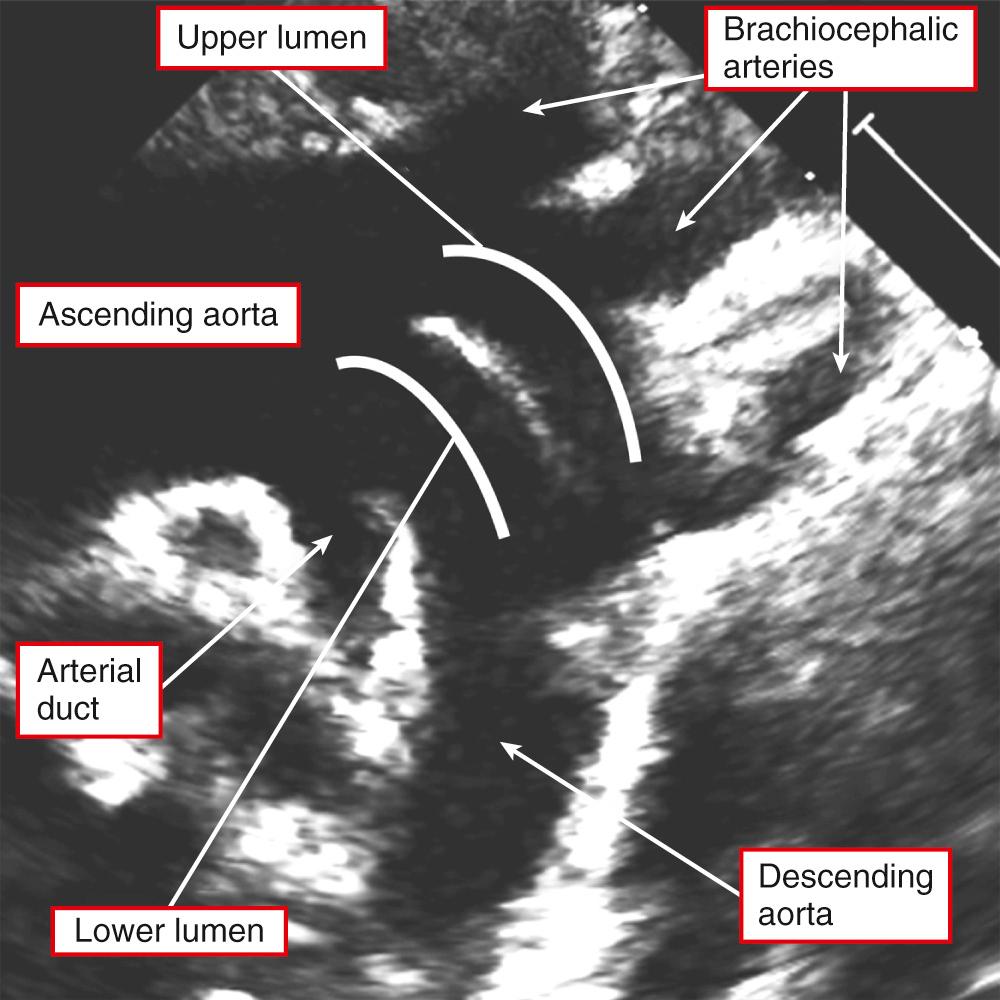
Become a Clinical Tree membership for Full access and enjoy Unlimited articles
If you are a member. Log in here